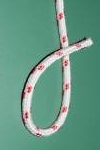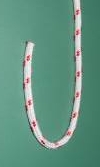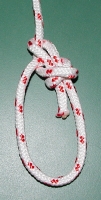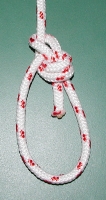
To see more details in the pictures, zoom in by holding down the CTRL key and pressing + several times.
Restore by holding down the CTRL key and pressing 0.
Thousands of knots have been discovered over the years, and people who tie knots for work or recreation have favorite knots which they use frequently (e.g. sailors, rock climbers, fishermen, weavers, farmers, search-and-rescue workers, etc.).
But what about the "average person" who doesn't tie knots very often? On the rare occasions when we need to tie something safely and securely, how do we know which knot to use?
The purpose of this website is to examine dozens of rope knots and gather together some opinions on these knots from people who study knots in depth.
In these pages you should be able to find some knots which you feel are "the most useful rope knots," and I'll describe the reasons for my own choices of "the most useful rope knots." In addition, I've provided links to a number of websites where you might find other useful knots. Your preferences might not be the same as mine, and in fact I find that my preferences have changed over the years.
For the average person who doesn't tie knots very often, it's helpful to learn just a few knots which are easy to remember and easy to tie, yet are secure and safe for a wide variety of purposes. By learning a few good knots and practicing them now and then, you'll be well prepared for those times when you need to tie knots in rope or string.
Every rope has a "breaking strength," which means that if we place enough of a strain on a rope then it will eventually break. The Safe Working Load of a rope is generally considered to be one-fifth of the rope's breaking strength, according to BoatSafe.com.
Knots tend to lower the strength of a rope. At my local hardware store, most of the ropes have a Safe Working Load of 300 pounds or less. If a rope has a Safe Working Load of 300 pounds, then we might assume that the rope should be safe for lifting an injured 200-pound man to safety (for example). But if we tie a knot in the rope, and if the strength of that knot is rated at 60%, then the Safe Working Load of our rope has been reduced to 180 pounds (60% of 300 pounds). The injured 200-pound man is now beyond the Safe Working Load of our rope because of the knot that we tied.
Modern ropes sometimes have a breaking strength of several thousand pounds when they're new, but what about the rope that's been sitting around in your garage forever? How much of a load is your rope capable of holding now? Do you know how to tie secure knots that won't slip loose and won't cause your rope to break under a strain?
Because of these issues, the best type of knot is one which reduces the breaking strength of a rope as little as possible, and is easy to remember how to tie properly, and is secure enough not to come loose. In addition, sometimes it's good for a knot to be easy to untie after being under a heavy strain.
Keep in mind that a knot might be secure in one type of rope, but it might easily shake loose in another type of rope. Be sure to test your favorite knots thoroughly.
It's surprisingly difficult to find solid research on the strengths of various knots. For some discussions of knot strength ratings, here are several topics at the forum of the International Guild of Knot Tyers:
Different people have different opinions and preferences, but certain knots tend to emerge as being commonly trusted in life-or-death situations such as rock climbing or rescue operations. If such knots are secure and trusted when lives are at stake, then it's reasonable that they're likely to be secure and trustworthy for the everyday purposes of the average person.
In the knotting world there are a number of confusing or ambiguous or poorly-chosen terms, and this problem has been discussed several times on the forum of The International Guild of Knot Tyers. For example, see Knotting Nomenclature and The Lexicon of Knotology.
Derek Smith and I attempted to address this problem by working on a new and cleaner terminology at the Nodeology wiki, but the traditional terminology is deeply entrenched and isn't likely to change.
Here are some definitions using the traditional terminology:
When a rope circles around and then crosses over or under itself, this is often referred to as a "loop":

The "working end" is the end of the rope which is manipulated the most while tying a knot (i.e. the end of the rope which is visible in all of these pictures).
The "standing part" is the main part of the rope (i.e. the part of the rope which extends beyond the top of all of these pictures).
A "bight" is essentially an open loop:

After you tie a knot, it's important to "dress" the knot properly. This involves making sure that all parts of the knot are in the right place and that the rope doesn't cross over itself unnecessarily. Each time a section of rope is sharply bent over something (such as another part of the rope), this can stress and tear some rope fibers. This is why it's important to dress the knot properly, because otherwise you're weakening the rope without realizing it. In the pictures below, the one on the left shows an improperly-dressed knot, and the one on the right shows the same knot which is properly dressed:
 |
 |
| Improperly dressed |
Properly dressed |
In addition, a knot should be "set" by being tightened before it's used. Otherwise the knot might become unstable or fall apart, which can potentially be disastrous.
Knowing the best knot to use, and properly tying it, and properly dressing it, and properly setting it can save someone's life or protect your possessions from damage.
In this series of articles I've mainly quoted from two recognized authorities on knots:
Here are several websites which provide a lot of information about knots:
Here are some computer programs for drawing knots:
If you have any questions about knots, I would recommend that you visit the online forum of the International Guild of Knot Tyers. There are knowledgeable people on that forum who will probably be able to answer your questions.
Here are all of the articles in this series:
Consider visiting my other websites!
You'll find:
Modification History
| 12/15/2010: | Added a link to an online searchable version of Ashley's Book of Knots. |
| 11/15/2010: | Shortened the article. Modified the "Introduction" section. Added some more terminology in the "Basic Terminology" section. |
| 03/03/2010: | Added a link to the new Nodeology wiki (created by Derek Smith). Added several more links to knotting websites. |
| 07/18/2009: | Added links to KnotTyer3D and KnotMaker. |
| 07/30/2007: | Removed a table of knot strengths (which I had found by searching the Web) due to dead links and poor/misleading data. Added links to several discussions of knot strength ratings at the forum of the International Guild of Knot Tyers. |
| 05/04/2004: | Added a new page called "Decorative Knots." Added pictures of a "loop" and a "bight" in the "Terminology" section. Added a link to some interesting "exploding" knots in the "References and Links" section. |
| 12/10/2002: | New article. |
Dave Root
Send e-mail to: dave@Layhands.com